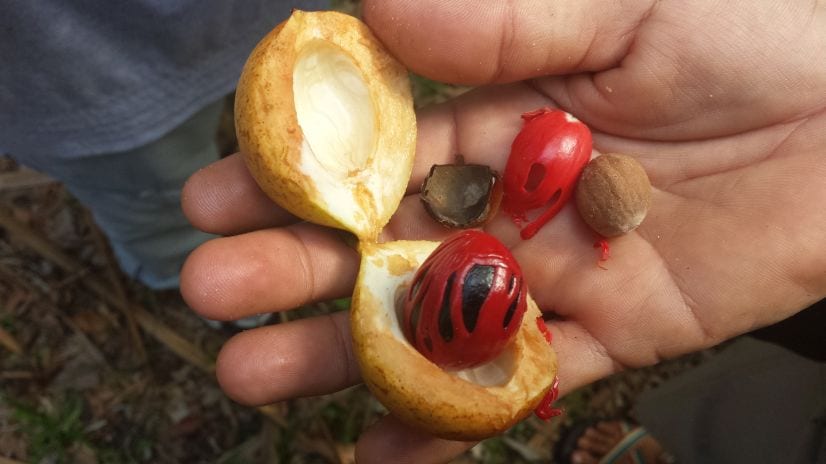
Spices
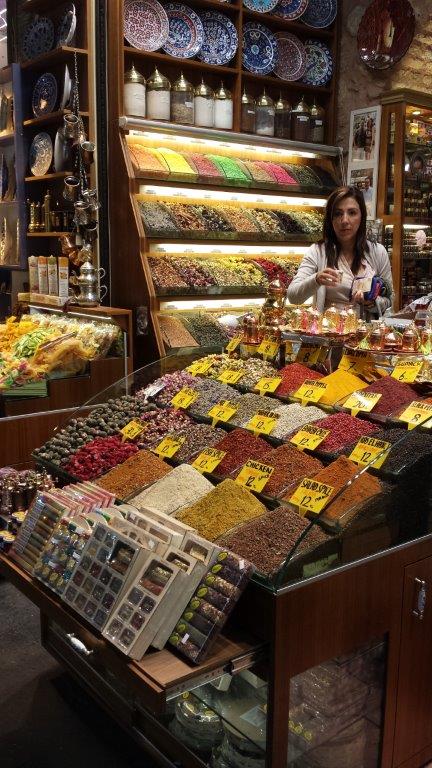
Grand Spice Bazaar – Istanbul
Image Roger Spencer – 2014
Introduction – Spices
The word ‘spice‘ is derived from the Latin ‘species’, which is also the root of the word ‘special’. Though meaning ‘type’ or ‘kind’ there is a strong association with special kinds . . . which in ancient times meant the plant kinds on which a levy was paid. The Alexandria Tariff was a Roman list of 54 luxury items on which 25% import duty was paid at the fifth century Egyptian port of Alexandria. Plants on the Alexandria Tariff included cinnamon, cassia, ginger, white pepper, long pepper, cardamom, aloewood and myrrh, highlighting the value placed on spices at this time. Black Pepper, the most widely used spice in the Roman empire, does not appear on the list because it was readily available as an Indian import.[13]
The Romans extended the Greek pioneering culinary use of herbs. The famous 428-recipe Roman cookbook of Apicius included Putchuk (Costus), Malabathrum (Cinnamomum spp.), Spikenard (Aralia racemosa), and Turmeric. By the Middle Ages spices were in widespread use across European society and, contrary to modern sensibilities, it was probably their mystical, religious, and other-worldly associations that kept them in favour for so long.
The major spices
Spices are not foods, they are enjoyed for their flavor and aroma rather than their nutritive value, although those used in cooking do stimulate the appetite and gastric juices. Their aromatic properties are due to essential oils and other compounds.
The distinction between herbs and spices is not clear-cut but, in general, it relates to the part of the plant being used although herbs do tend to be warm temperate plants and spices tropical. Culinary herbs consist of the leafy green part of a plant, they are mostly temperate in origin. Spices are sourced from other parts of the plant than the leaf such as the root, stem, bulb, bark, resin, or seeds and most spices have originated in the Asiatic tropics. Following Purseglove (1981), the major ones are: cardamon, cinnamon and ‘cassia’, chillies, cloves, coriander, ginger, nutmeg and mace, pepper, pimento, turmeric, and vanilla; lesser spices include angelica, capers, caraway, celery, cumin, dill, fennel, fenugreek, frankincense, galangal, garlic, horeseradish, juniper, liquorice, mustard, myrrh, onion, poppy, saffron, sandalwood, star anise, and sesame. Some plants have the distinction of being used as both herbs and spices – like coriander, fennel, and dill. Some cultivated plants have no known ancestors in the wild and are therefore presumed extinct, this being the case for the broad bean, date palm, ginger, lentil, turmeric, and onion.
The herbs and spices that have figured substantially in world trade can be divided into two groups based on the climate of the countries where they grow: temperate and Mediterranean – coriander, cumin, fennel, frankincense, garlic, juniper, mint, myrrh, and thyme. Then there were the Far Eastern (and some Indian) tropical spices so central to world trade and global politics in the Age of Discovery: cinnamon, cloves, mace, nutmeg, pepper and, to a lesser extent, ginger and sandalwood.
Leafy culinary herbs, mostly from temperate climes, had long been used in European cuisine but the more sought-after spices were sourced from other parts of the plant, and those from the tropics were especially prized. Their alluring flavours and aromas were used to enhance and sometimes preserve bland food and to mask the unpleasant taste of salted and deteriorating meat. In the East spices added flavour and piquancy to the daily diet of rice. Bland or acidic wine could also be made more palatable when ‘spiced up’ in a tradition we still see today as winter mulled wine, spiced ale being a favourite of the Middle Ages. Pomanders, small containers of mixed herbs were worn around the neck or placed in cupboards and drawers to freshen the air and clothes – even ward off the plague and other infections.
Ancient Egyptians used ‘cassia’ and cinnamon during the ritual of embalming.
What was it about spices that inspired men to circumnavigate the world and launch a global mercantile revolution? Why did such unlikely commodities command such high prices?
Traders found spices easy to dry, store and transport but they had additional enticing qualities beyond the practical medicinal and culinary ones: there was the mystery of their source in distant exotic lands, the romance of the Arab trade, their prohibitive expense, and the intimation of mystical properties suggested by their exotic aroma. They were considered aphrodisiacs that could also enhance fertility. No doubt their religious and spiritual associations increased their attraction as it was believed that their fragrance awoke the senses of the gods, thereby facilitating communication with the divine – a tradition that continues today as the burning of incense in the High Church, both Catholic and Anglican. Like gold and precious jewels spices were initially associated with a social elite and therefore a luxurious and much-coveted indication of social status.
Spice dealers were known in England at this time apothecaries, rolling into one vocations of botanist, chemist, druggist, herbalist, merchant, and physician. In France today’s grocery is called an épicerie, or spicery, recalling their earlier history. Pimento, chillies and vanilla all came from tropical America but it was the Far East that caught most attention. ‘Spice Islands’ was the collective name for the group of small Moluccan islands, mostly in the Banda Group, with indigenous plant populations of nutmeg and cloves, their location remaining a mystery to Europeans for more than 1000 years after they were first used in Europe.
Cardamon, Elettaria cardamomum
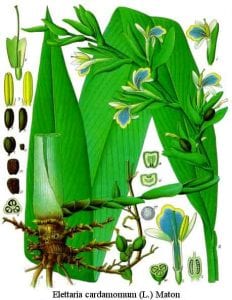
Eletteria cardamomum
Cardamom
Köhler’s Medizinal-Pflanzen 1897
Courtesy Wikimedia Commons
Plant – Of the Indian and Sri Lankan spices pepper is the king and cardamom the queen. Cardamon is related to ginger, which is also in the botanical family Zingiberaceae, and native to Sri Lanka and southern India in monsoon rainforest of the Western Ghats. Plants are propagated by seed or division. The fruits are picked when slightly unripe. The seeds have a distinct aroma and are slightly pungent to taste. Uses – used as a flavouring in cooking, especially curries, cakes and bread. In India they are added to chewing quids especially those of the betel palm Areca catechu and are an important element of Ayurvedic medicine. Used to flavour coffee in the Middle East. Associated with aphrodisiac properties especially in ancient Greek and Roman culture. Steam distillation releases an essential oil used perfumery and flavouring. History – Up to 1800 world supply came from wild stocks in southern India after which cultivation occurred. It is believed to have been traded by the Greeks in 300-400 BCE and by the first century CE Romans were importing large quantities from India and its introduction was taxed in Alexandria in 176 CE. [5] There is some doubt that, although the word cardamom was used for these early spices, these plants they may not have been the cardamons of today. Theophrastus refers to an inferior amomon and superior kardamomon but we cannot be sure what these actually were. There are few Indian records of Indian trade in the plants although it was certainly traded from at least the time of Ibn Sena (980-1037). In Chinese medicine it dates back to about 1000 CE. Portuguese herbalist Garcia da Orta in 1563 distinguished between the smaller, non-aromatic E. cardamomum var. cardamomum of southern India and the larger and aromatic E. cardamomum var. major from Sri Lanka – perhaps the distinction made by Theophrastus. Cardomum was an important component of the Medieval European pharmacy. Amomon, native to Java as A. compactum and known as Round Cardamom, sometimes used as a substitute for true cardamom, is a relative in the Zingiberaceae which confuses both identification and historical record. Production – Cultivated in this region, southeast Asia, and Guatemala. India is still the largest producer supplying about 80% of the world’s supply: Sri Lanka has been overtaken by Guatemala. Export to other parts of the tropics have not been very successful.
Chillies, Capsicum spp.
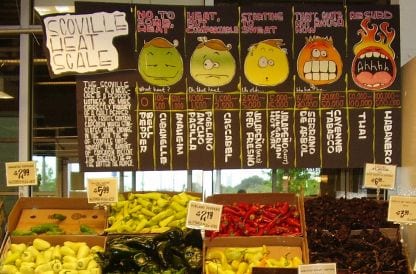
Capsicum spp.
Chilli Peppers
Peppers of varying heat as shown on the Scoville scale. Central Market, Houston, Texas.
Courtesy Wikimedia Commons, WhisperToMe – Art by Lisa Stewart
Plant – Depending on the kind of plant and the way it is used, chillies may also be called paprika, pimiento (not pimento), sweet pepper, red pepper, cayenne, or bird pepper. This may lead to confusion with Black Pepper, Piper nigrum, pimento and an assortment of other plants that have acquired the common name pepper. Uses – The active ingredient of chillies is capsaicin. Perhaps the best known plants are the mild-flavoured Green or Bell Peppers Capsicum annum var. annuum which also come in red and yellow forms and are eaten raw or cooked when ripe, sometimes stuffed or pickled. Paprika is the bright red ground fruits used as a condiment and comes in several forms, the Spanish being milder than the more pungent Hungarian paprika that is used in goulash. Plants known more generally as chillies are highly pungent forms of C. annuum and come in myriad variants. A few other cultivated species include ‘Tobasco’, which is a cultivar of C. frutscens, C. baccatum and C. chinense (also in Caribbean) in South Amrica. C. pubescens from the Andes produces the most pungent flavours and has been widely cultivated in the tropics, livening up rice, beans, and cassava while also being an ingredient of curry spice. Extracts can be used in a variety of ways to flavour and enhance food and drink. There are a variety of medicinal uses. The fruits are an excellent source of vitamin C. History – When Columbus found and recorded chillies in his journal (entry 15 Jan. 1493) they were widely distributed and used across the Caribbean, Mexico, Central and South America. Native peoples used the plant as a medicine, condiment and in many other ways. Records of their use date back to archaeological finds from around 7000 BCE and they are one of the oldest cutivated plants of the Americas. It is possible that they were taken from South America to the West Indies in prehistoric times.[7] He had expected to find pepper and hence the name: thanks to him they were soon also found across warm regions of the Old World[6] Chillies taken from South America we soon distributed into Asia, herbalis Fuchs recording three different kinds in India of 1542 and known as the ‘Pepper of Calicut’.[8]
Cinnamon & camphor, Cinnamomum zeylanicum (C. verum)
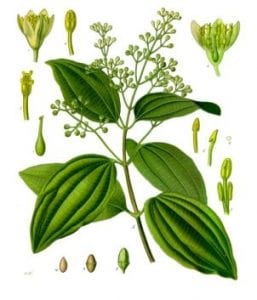
Cinnamomum zeylanicum (syn. C. verum)
Cinnamon
Köhler’s Medizinal-Pflanzen 1897
Courtesy Wikimedia Commons
Plant – In the botanical family Lauraceae, Cinnamomum zeylanicum is native to SW India and Sri Lanka and widely cultivated in the tropics. Uses – for the dried bark rolled into ‘quills’, while C. burmannii is the source of cinnamon in Java and Sumatra. Cinnamon sourced outside India was, confusingly, referred to as ‘cassia’, a botanically unrelated genus of plants. Cinnamomum cassia native to China. Cinnamomum camphora from Indonesia and Borneo is the source of oils and crystals that are used in a similar way to Frankincense, also the highly fragrant camphor wood. The spice is used in baking, pickling, and cooking generally. An oil, used in perfumery and other products, is obtained from the bark using steam distillation while a different oil is obtained from the leaves using the same process. Oils from different species have different aromas, cinnamaldehyde coming from true cinnamon, eugenol smelling like cloves, and safroles which often smell like camphor, camphor oil itself being extracted from Cinnamomum camphora from China, Taiwan and Japan. Different-smelling cultivars with local names are known in Sri Lanka. History – Whether cinnamon, as we know it botanically today, was used in Egyptian embalming remains contentious as do similar claims for use by legendary founder of Chinese medicine Shen Nung.[3] The first reliable accounts relate to Greek and Roman sources although their Arab traders kept the source secret. Today – Cultivated in the southeast is also cultivated commercially in Myanmar and Indonesia.Sri lanka is still the largest producer, followed by the Seychelles, with small quantities from Madagascar.
Cloves, Syzygium aromaticum
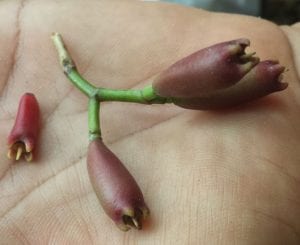
Syzygium aromaticum
Fresh cloves
Spice Islands
Culinary cloves – unopened sun-dried calyx and flower buds
Image – Roger Spencer – December 2015
Plant – The most mysterious of the spices being a 10 m tall tree with fragrant leaves, native to just five small Moluccan islands: Ternate, Tidore, Moti, Makian and Bacan. The flowers, which are borne in clusters, mature from green to pink then copper-red. The fragrant clove (Latin clavus – nail) is produced when trees are about four years old and consists of the unopened sun-dried calyx and flower bud of a small tree picked from June to December, maximum yield of about 15kg/tree is achieved after about 20 years. As a forest tree adapted to shady conditions and with a seed viable for only a short period this was not a plant that could be easily propagated. Uses – From antiquity cloves have been used whole, ground, or as an oil for their flavour, aroma, antibacterial, and analgesic properties. Oil of Cloves has long been used in dentistry to dull toothache. Early mariners claimed the smell of the cloves could be detected from miles out to sea.[8] Production – Indonesian men, who are heavy smokers, use cloves in their cigarettes, known as kreteks. Cloves are regarded as the most precious of all the spices, the Dutch securing their trade until 1770 when plants were smuggled to Mauritius and Zanzibar, breaking the Dutch monopoly.
Coriander, Coriandrum sativum
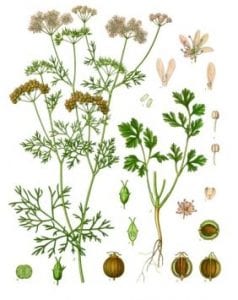
Coriandrum sativum
Coriander
Köhler’s Medizinal-Pflanzen 1897
Courtesy Wikimedia Commons
Plant – An annual often weedy wayside herb from the Mediterranean, mostly wild over Western Asia and southern Europe but its possible spread by humans is not known. A plant that can claim to be both a herb and a spice: often associated with turmeric. Uses – The aromatic leaves, the aroma pleasant for some but repellant to others, are used as a food flavouring is characteristic of many members of the family Apiaceae (Umbelliferae) which includes caraway, cumin, dill, and fennel. Uses – The fruits are a major ingredient of curry powder (remarkably a spice imported to India from Europe) but also used as a seasoning, especially in sausages, cakes and confectionery. An oil extract is used as a flavouring. There are various medicinal properties, notably as a carminative, digestive, and anti-flattulent. It has been used in assorted love potions and aphrodisiacs. Name derived from the Greek koris-bedbug, the smell of the green unripened fruits. History – One of the oldest-known spices. Desiccated seed has been found in the Pre-Pottery Neolithic B level (c. 7,600— circa 6,000 BBCE), probably the oldest archaeological record. find of coriander. About cupful of seed was found in the tomb of Tutankhamen. The plant does not grow wild in Egypt today and this suggests that coriander was cultivated by the ancient Egyptians.[4] Recorded in Egypt as early as the Ebers Papyrus in 1550 BCE, also in the Bible and Sanskrit classics. Recorded by Classical authors, Pliny claiming that the best quality coriander in his day was sourced from Egypt and it was used by the Romans as a meat preservative. It is recoded from the shops of Pompeii in the first century CE and it was introduced to England and northern Europe by the Romans, French monks using it as an ingredient of the liqueurs Chartreuse and Benedictine and it was probably Roman merchants operating along the Silk Road and sea lanes across the Indian Ocean that introduced this spice to India.[9] Production – Widely grown in India, Russia, central and eastern Europe and Morocco.
Frankincense
Frankincense or Gum Olibanum is a resin obtained from Boswellia sacra a tree that grows on the Arabian Peninsula in Oman and Yemen, also on the northeastern Horn of Africa in Somalia. The milky sap dries into combustible pellets.
Ginger, Zingiber officinale
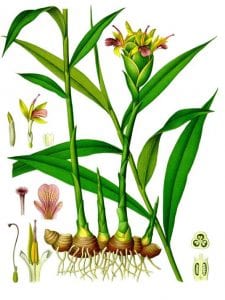
Zingiber officinale
Ginger
Köhler’s Medizinal-Pflanzen 1897
Courtesy Wikimedia Commons
Plant – Ginger, Zingiber officinale (officinale – of commerce), is a rhizomatous herbaceous perennial in the botanical family Zingiberaceae that is usually grown as an annual. Grown in antiquity in Asia, mainly India and China, and though assumed to be native to Southeast Asia or India the plant is now unknown in the wild. The name is derived from the Sanskrit singabera. Uses – The dried and peeled, sometime powdered, aromatic rhizomes are widely used as a food and flavouring, sometimes bottled in syrup or crystallized. Well-known in drinks like ginger Beer and ginger wine, Medieval European posset and porter, also as an ingredient of curry powder. An oil is produced by steam distillation and is used for flavouring and perfumery. It has a wide range of medicinal uses and hasa reputation as an aphrodisiac. As far back as the fifth century CE potted plants were taken aboard oriental vessels embarking on the long voyage from China to southeast Asia and used as a food that would help prevent scurvy centuries before Europeans encountered scurvy on their maritime expeditions.[11] The spice had certainly found its way to Germany and France by the nineth century, England by the eleventh century and in the fourteenth century it was as common as pepper.[11] Gingerbread was a favourite of the Elizabethan [11]History – From antiquity used as both a spice and medicine in India and China and mentioned in the Analects of Confucius (551-479 BCE) and in th Q’ran. Greeks and Romans obtained ginger from Arab traders who kept its source in India a secret. Marco Polo observed the plant in China, Sumatra, and Malabar. Arabs took rhizomes to East Africa, the Portuguese to West Africa and the tropics in the sixteenth century. Calicut was the major emporium until about 1500. The Spaniard Francisco de Mendoza introduced the plant to Mexico. Production – Preserved ginger produced in Guangchow (Canton) is exported from Hong Kong. However, about 50% of world production comes from India although it is also obtained from China, Taiwan, Nigeria, Jamaica, Thailand and Australia. [10]
Nutmeg & mace Myrica fragrans
Nutmeg being the kernel (seed) of the golf-ball-sized fruit and mace the thin red leathery webbed tissue (botanically the aril) between the kernel and the pulp. The mace is separated from the fruit and sun-dried from June to December. The pulp is used for cooking when finely grated, or as a confection. Plantation trees are often grown in the shade of giant Kenari trees in the genus Canarium that themselves produce tasty edible nuts. Nutmeg is native to the remote and tiny eastern Moluccan islands Banda, Lontar, Ai, and Run. After the Dutch monopoly on trade was broken nutmeg was widely grown through the Indonesian archipelago.
Nutmeg & mace are obtained from the shrub Myrica fragrans, nutmeg being the kernel (seed) of the golf-ball-sized fruit and mace the thin red leathery webbed tissue (botanically the aril) between the kernel and the pulp. The mace is separated from the fruit and sun-dried from June to December. The pulp is used for cooking when finely grated, or as a confection. Plantation trees are often grown in the shade of giant Kenari trees in the genus Canarium that themselves produce tasty edible nuts. Nutmeg is native to the remote and tiny eastern Moluccan islands Banda, Lontar, Ai, and Run. After the Dutch monopoly on trade was broken nutmeg was widely grown through the Indonesian archipelago.
Pepper, Piper nigrum

Piper nigrum
Black Peppper
Köhler’s Medizinal-Pflanzen 1897
Courtesy Wikimedia Commons
The Plant – The Greek peperi, Latin piper and English pepper are all derived from the Sanskrit pippali. Cultivated plants are woody vines with small hermaphrodite flowers dangle in long catkins that form a spike of red fruits. Though many plants are called ‘pepper’ (in Australia Peppercorn Tree is Schinus molle), the common culinary table spice is P. nigrum, a vine native to India’s southwestern Western Ghats on the Malabar Coast, possibly also in Assam and northern Myanmar. Uses – The spice derived from the fruit is known as either Black Pepper (the whole green fruit dried in the sun until black), White Pepper (with the outer coat removed after soaking this was a milder condiment), or Green Pepper (unripe fruits dried and pickled) and the active ingredient is the pungent alkaloid piperine. History – Pepper, sometimes called black gold, has been the most historically significant spice. Pepper was mentioned by Theophrastus (372-287 BCE) in his Enquiry into plants Volume 2 where he recognized the lesser-known species P. longum, Indian Long Pepper, an early introduction to Europe preferred by the Romans. Though nutmeg and cloves were the magical and most highly desirable spices it was pepper that provided the most lucrative trade and it was one of the first spices traded between East and West. The overland route from India to Europe was by camel and packhorse and it passed from India to Pakistan, Afghanistan, Iran, Iraq, Syria, Turkey, the Balkans and, finally, to Venice. The loyalty of the Veneti tribe to Rome had been rewarded with a gift of marshy lands that had prospered and, by the 800s, had become a township called Venice. By the early 1500s Venice had the largest merchant navy in Europe, had developed a sophisticated banking system with branches in Europe’s main cities. Spices generated much of the wealth in Venice, driving the spice race that was launched from the Iberian Peninsula. Pepper served as a currency for the storage and exchange of wealth, it was a useful source of government tax revenue. In the London of 1180 wholesale merchants formed a pepperers guild which later merged with the spicers guild and, much later, in 1429 the Grocer’s Company. Pepperers and spicers were the forerunners of the later apothecaries, this indicating the vital role of spices in western medicine.[2] In the Middle Ages meat was salted and pepper was also used as a preservative and for curing and flavouring unpleasant or deteriorating meat. By the mid-nineteenth century world-wide production was high and being available from many sources the cost had become trivial. The maritime route from India up the Red Sea to Egypt and overland to Alexandria and thence by sea to Mediterranean ports was followed from Roman times until the fall of Constantinople to Turkish forces in 1453 although the Persian Gulf was also used. Plantations were established across the tropics in the late eighteenth century and every city had a spice market. Although native to India, pepper plants had been transported to Java, probably by Hindu colonists, in the period 100 BCE to 600 CE and, by 1600, Sumatran and west Javan sources dominated world supply.[7] Marco Polo in is memoirs published in 1298 describes the cultivation of pepper plants in Java in 1280 and of the Chinese junks laden with baskets full of the spice.[1] Today – pepper is the most widely used spice in Europe and America with a wide range of culinary uses and digestive and medicinal properties. Production – Now widely distributed throughout the tropics there are three main areas of production: in the late twentieth century the major producers were Malaysian Sarawak; and Indonesia although Brazil was increasing production, but by 2011 4 M tonnes worth about $2 billion were marketed Vietnam, now the world’s largest pepper producer (H. ). Singapore currently serves as the world’s major distributing entrepot.
Sandalwood, Santalum spp. esp. S. album
Indian Sandalwood, has aromatic yellow wood that retains its fragrance for a long time. Essential oils are also extracted.
Incense slow-burning plant products with a strong aroma occur in many cultures and are made of different plant products. Church incense is a blend of plant resins, mostly frankincense. The milky juice from the tree dries out into grains. Bark residue can cause a light-yellow color. The grains are washed in natural oil and can be mixed with other incense types, resins and substances such as sandalwood, myrrh, benzoin and lavender.
Turmeric, Curcuma domestica
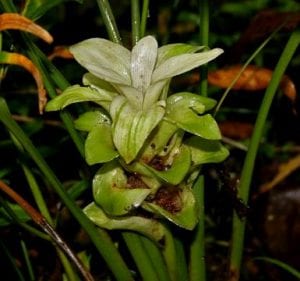
Curcuma domestica
Turmeric
Goa, India
Courtesy Wikimedia Commons – J.M. Garg
Plant – Turmeric is in the same botanical family, Zingiberaceae, as ginger and cardomum. It is presumed to be native to India but it is unknown in the wild, having arisen by constant selection and vegetative propagation. A number of cultivars are known in India and named after the localities where they are grown. The active ingredient is curcumin. Uses – Rhizomes are used as a spice and for making a yellow to orange, Brown or red dye. The major use for turmeric is as a yellow, musky-flavoured constituent of the curry powder used to enhance the rice dishes that form the staple food of India, Bangladesh, Pakistan, Indonesia, and South East Asia. Rhizomes are boiled, dried and powdered. The yellow-coloured rice is a feature of ceremonies. The plant is believed to have magical properties and is used in the rituals of birth, marriage, and death, especially in relation to fertility, and an assortment of medical remedies. An established element of Hindu ceremony. When mixed with alkali the dye can be converted to various reddish shades used for wool and cotton fabrics. Has both the smell and colouring of saffron. History – An ancient spice probably distributed to the Celebes, Moluccas and Polynesia in prehistory, and China before the seventh century: it is recorded in China by Marco Polo in 1280. Possibly reaching East Africa in the eighth century, West Africa in the thirteenth century, Jamaica in 1783.[12] Production – Widely cultivated in the tropics especially Indonesia and South East Asia but India is the major source.
Economic botany
Following an initial phase of discovery and scientific exploration prominent European governments began building a network of trading hubs that linked the Indo-Pacific and Caribbean regions. These took the form of provisioning ports on major trade routes and they often included colonial satellite botanic gardens linked to European cities.
Dutch tropical botany
Dutch botanists were among the first colonial scientists as, during the Dutch Golden Age, strategic colonial outposts were established in Batavia (1619), Cape Town (1679), and Buizborg (Bogor, 1817). Famed for bulbs imported from Turkey and the Levant and later treasures from America Dutch horticulture had reached world attention through the astronomical prices demanded for tulip bulbs during the 1630’s craze of tulipomania. From 1679 to 1706 the administration of the Dutch East India Company was a rich one for European horticulture, especially under the botanically enlightened commandant Robert Gordon (1743-1795).[16] The hunt for spices and other plants of economic and medicinal potential had aroused an interest in tropical floras culminating in publications like Hendrik van Rheede’s Hortus Indicus Malabaricus (1678-1693) dealing with the medicinal plants of the Indian state of Kerala, and Rumpf’s Herbarium Amboinense (1741). Dutch botanic gardens at Leiden and Amsterdam were pre-eminent in the period from the end of the 17th to early 18th centuries supported by a garden at the Cape of Good Hope.
The Dutch tradition of linking of plant collectors, botanic gardens, and natural scientists (especially botanists, horticulturists, and botanical artists) no doubt influenced similar connections that we more frequently associate with France and England. Holland was one of the earliest European countries to establish botanic gardens: the Hortus Botanicus Leiden (1587) and Hortus Botanicus Amsterdam (1638). Jan Commelin (1629-1692) was professor of botany when plants were being imported from the Cape and Ceylon. He assisted in the development of the Botanic garden in Amsterdam, the Hortus Medicus (later Hortus Botanicus). Accumulating a small fortune by trading herbs and drugs in Amsterdam and other Dutch cities he built up a large collection of exotic plants on his estate ‘Zuyderhout’ near Haarlem. His botanical work had included facilitating the publication of Hortus Malabaricus, and Nederlandse Flora (1683). He also prepared Horti Medici Amstelodamensis Rariorum (1697) which described plants of the East and West Indies collected mostly during the operations of the Dutch East India Company. The book was illustrated by Jan Moninckx and his daughter Maria Moninckx. Jan’s nephew Caspar Commelin (1667-1734) became the director of the Amsterdam Botanic Garden following Pieter Hotton (1648 – 1709) of Leiden who had been elected a member of the Royal Society in 1703 and correponded regularly with Londoner Hans Sloane, and he finished the work of his uncle and had it published with the help of Professor of anatomy and botany Frederik Ruysch. Ruysch’s daughter Rachel Ruysch (1664-1750) was an outstanding still life and flower painter from the Northern Netherlands whose work was surpassed only by that of Jan van Huysum (1682-1749) who elevated flower painting to a new level.
In 1679, at age fifteen, Ruysch was apprenticed to Willem van Aelst, a prominent flower painter in Amsterdam. His studio in Amsterdam looked out over the studio of the flower painter Maria van Oosterwijck’. Rachel knew the flower painters Jan and Maria Moninckx who illustrated Horti Medici Amstelodamensis Rariorum, also Alida Withoos and Johanna Helena Herolt-Graff, all of a similar age. They also worked for Agnes Block who owned a country estate on the Vecht river in Loenen replete with curiosities and gardens stocked with a special exotic plant collection. Like Rachel’s father these botanical artists regularly communicated with plant collectors including both Jan and Caspar Commelin.
Rachel also knew artist Otto Marseus van Schrieck who, like her father, worked periodically for the Hortus Botanicus Amsterdam. Rachel painted for six decades as she produced ten children.
Another insight into the world of botany and horticulture during this period is provided through the life of German-born Rumphius (Georg Rumpf, 1627-1702) who was employed by the Dutch East India Company to study the flora of the Moluccas. Rumphius arrived in Batavia in July 1653, moving to the Ambon archipelago in 1654. In 1657 became ‘junior merchant’ on Hitu island, north of Ambon undertaking a study of the flora and fauna of these Spice Islands. His botanical reputation grew and earned him the sobriquet Plinius Indicus (Pliny of the Indies).
Rumphius is best known for his book Het Amboinsche Kruidboek or Herbarium Amboinense, a catalogue of the plants of the island of Ambon, a book still used for botanical studies of the Moluccan flora. Rumphius maintained communication with scientists in Europe and was a member of the scientific society of Vienna. Completed before there was universal acceptance of Linnaean binomial nomenclature his work included nomenclature, illustrations, and descriptions for 350 plants, and his material contributed to the later development of the binomial scientific classification by Linnaeus. Herbarium Amboinense finally arrived in the Netherlands in 1696 but since it contained information on potentially important commercial plants the East India Company decided that such sensitive information warranted suppressing publication so it was not released until 1741, after his death.
Another German-born physician Paul Hermann (1646-1695), after graduating from the famous medical school at Padua, was employed by the VOC working in Ceylon in the 1670s where he grew custard apple, guava, cashew nut, capsicum and cotton, all introduced from the Americas.[14] He was subsequently appointed Director of the Hortus Botanicus Leiden in 1679 where he remained for 15 years, a period in which he can claim to have built it into the greatest botanical garden in Europe at that time. His most notable publication was Paradisus Batavus (Dutch Paradise, 1698) an account of the plants cultivated in the botanic garden. When a student of botanist Joseph de Tournefort in Paris he had befriended fellow student William Sherard, an English botanist who worked at the University of Oxford, and it was Sherard who secured the publication of his book. Hermann’s herbarium collections were cited by Linnaeus in Flora Zeylanicum and Species Plantarum.
Dutch botany reached its zenith in the early eighteenth century with the international fame of Johannes Burman (1707-1779) at Amsterdam and, more especially, through medical professor Herman Boerhaave (1668-1738) at Leiden. Both had living collections close at hand in the Amsterdam and Leiden botanical gardens which, at that time, were unsurpassed in plant numbers and the quality of the collections.
Holland at this time was the European centre for publishing and printing and Dutch botanists were leading taxonomy with their discovery and description of plants outside the immediate European world. It was at this time that the young Linnaeus decided to go to Holland.[17]
Boerhaave recognized Linnaeus’s talent and potential. On Boerhaave’s recommendation Linnaeus moved to Holland, employed from 1736 to 1738 as physician to the household of George Clifford III. Clifford, who was a wealthy Dutch merchant banker and a director of the Dutch East India Company, is known for his keen interest in plants and gardens with a fine plant collection on his estate at Hartekamp where Linnaeus had proudly noted the first flowering in Europe of a banana in the 1730s(check). Many specimens from Clifford’s garden were also studied by Linnaeus for his Species Plantarum (1753) which established for all time the convention of binomial nomenclature for living organisms. The significance of the binomial system was that it formalized the classification and documentation of the world’s plants – their names, descriptions and literature – at a time when this had become a matter of great urgency.
Also, by this time the European craving for garden treasures was gathering momentum. Linnaeus’s teacher, Hermann Boerhaave who was appointed a lecturer in medicine at Leiden University in 1701, stated in his Index Alter Plantarum as early as 1720, some time before the epidemic of Botanophilia:
‘practically no captain, whether of a merchant ship or man-of-war, left our harbours without special instructions to collect everywhere seeds, roots, cuttings, and shrubs and bring them back to Holland’
Following the political and private fortunes of the times the fashions, ideas and extravagancies of Dutch cities would be later be passed on to London, Paris, Vienna and other European cities.
By 1770 the intellectual botanical centre had passed from Linnaeus in Uppsala, to Banks’s Soho Square in London and the Jardin des Plantes in Paris.[18]
Timeline
BCE
Egyptians were renowned for their highly developed medicine involving many aromatic and strongly flavoured herbs and spices some of which were used to assist the process of embalming. In Europe the desire for and trade in herbs and spices marked the initial phase of systematic plant aquisition from foreign sources – a first hint of the plant globalization to come.
1721 – Cloves excavated from a kitchen in Terqa, Syria dating back to this time
1508-1458 – Pharaoh Hatshepsut returns live myrrh plants from an expedition to Punt
200 – Han Dynasty records report the use of cloves
138 – Silk Road established across Central Asia
50 – Greco-Roman trade with India
CE
77 – Pliny the Elder mentions cloves in his Naturalis Historia
618 – Tang Dynasty and Silk Road stability for 300 years
661 – Damascus the trading centre of Muslim world
671 – Arab traders arrive in Guangzhou
750 – Muslim focus turns to Baghdad
1291 – Islam established in Northern Sumatra<
1402 – Spain finally occupies the Canary Islands
1405 – First voyage of Admiral Zheng He Treasure Fleet
1402 – Portugal occupies the Madeiras
1427 – Portugal occupies the Azores around this time
1453 – Ottoman Turks overrun Constantinople, gaining control of the Spice Road
1484 – Islam reaches Ternate
1488 – Portuguese explorer Bartholomew Diaz rounds the Cape of Good Hope; Columbus suggests to Portuguese court a westward voyage to find the Spice Islands
1492 – Columbus following a western route to the East Indies arrives in the Bahamas thus discovering the Americas but believing he has landed in the East Indies
1494 – Treaty of Tordesillas divides the world between Spain and Portugal
1498 – Vasco da Gama rounds the Cape of Good Hope, follows the uncharted West African coast and crosses the Indian Ocean to anchor off Calicut: Europe’s first direct sea voyage to Asia
1510 – Alfonso de Albuquerque captures Goa for Portugal
1511 – Alfonso de Albuquerque captures Malacca for Portugal
1512 – Antonio de Abreu arrives in Banda and Francisco Serrão in Ternate
1513 – Portuguese armada from Malacca reaches Banda to trade nutmeg
1517 – Ferdinand Magellan suggests to Spanish court a westward voyage to the Spice Islands
1519 – Magellan sets sail for Moluccas
1521 – Magellan dies in Mactan, Philippines but the armada proceeds to Ternate
1522 – Juan Sebastian El Cano completes the Moluccan expedition & is the first to circumnavigate the world
1523 – Fort Gamalama constructed on Ternate
1529 – Spain signs the Treaty of Saragossa ceding the Moluccas to Portugal
1575 – Portuguese driven from Ternate
1579 – Englishman Francis Drake in the Golden Hind meets Sultan Baabullah on Ternate and in 1580 completes the second circumnavigation of the world
1596 – Dutch fleet arrives in East Indies
1600 – Second Dutch fleet makes contact with Ternatan Sultan
1601 – English East India Company formed
1602 – Dutch East India Company (VOC) formed
1605 – Portuguese take the fort on Tidore
1607 – Spanish take Fort Gamalama on Ternate
1619 – Dutch establish the town of Batavia based on Amsterdam
1667 – English with the Treaty of Breda exchange the island of Run for Manhattan
?1673 – Spanish abandon Ternate
1669 – Dutch establish a monopoly of the Spice Islands with the capture of Macassar
1754-1770 – Nutmeg plants established by Pierre Poivre in Mauritius
1795 – Cloves and nutmeg well established in the French colonies of the Caribbean
Plant commentary & sustainability analysis
What follows is an example of the way that Sustainability Analysis can be applied to a historical situation. There are, of course, many interpretations, but the process of analysis itself challenges the analyst to think about the future consequences of past actions.
Ancient trade routes, both land and sea, were arteries for the spread of not only luxuries and vital resources, they were also the conduits for ideas so vital to physical and intellectual changes in social organisation and cultural adaptation. There is much to still be learned about early contact between peoples across Afro-Eurasia and the Indonesian trade with India, China and southeast Asia – the global redistribution of plants and animals and the spread of disease.
East-West contact entailed the intellectual challenge of reconciling or overcoming divergent philosophies, religions, ideologies, and world-views. There was, of course, conflict – but the Hellenistic period was marked by the fusion of cultures and artistic forms called syncretism. Greco-Buddhism would spread along the Silk Road to China and give rise to Zen Buddhism. Arising between c. 350 BCE to 450 CE in Bactria and northern India this followed the establishment of the Indo-Greek Kingdom and the Hellenized Kushan Empire. Greco-Buddhism is perhaps most evident in in the fusion of artistic styles in sculpture although there may well have been a sharing of ideas through incorporation into Mahayana Buddhism.(see Greco-Buddhism 1) From the 1st century CE Buddhism would diffuse into China, Korea, Japan, Philippines, Siberia, and SE Asia.
Faiths offered explanations and it was along the Silk Road that languages and religions would meet: the Chinese eastern religion of Confucianism; the Indian religions of Hinduism, Jainism, and Buddhism; the Persian religions of Zoroastrianism amd Manichaeism also associated with Nestorianism; and, at the western end, the Abrahamic religions of Judaism, Christianity and Islam. Afro-Asiatic languages mixed with Indo-European and Sino-Tibetan … Greek with Sanskrit, Semitic, Turkic and others.
Buddhism and Hinduism in Southeast Asia was associated with Indian commerce, culture, and cuisine (notably Malaysia and Indonesia) with Islam ariving in the 10th century and, later, influences from China. Christian missionaries, like Francis Xavier were also active throughout the East.
It was through the spice trade and Dutch merchant ships blown off course to flounder on Australia’s western coast that first drew the world’s attention to the ‘great southern land’.
The spice trade was, through the Age of Discovery into the Enlightenment‘s Age of Reason, the opening up of a global economy created by the Spanish trading gold and silver from mines and other sources in Mexico and Peru for goods, especially spices, from Asia and the East Indies.
The Dutch followed Portugal and Spain in establishing an overseas colonial empire their colonial possessions in the East Indies accumulated through the private enterprise of the Dutch East India Company. The VOC, effectively the world’s first multinational stock company, continued the Spanish and Portuguese mercantile tradition of drawing in both the military and government. The Dutch Golden Age, founded on the spice trade, was a botanical opportunity as the Leiden Botanical Garden and its medicinal faculty became the world’s best. It was the model of the outstanding physic-botanical garden of the Dutch at Leiden that so impressed Phillip Miller at the Chelsea Physic Garden in London and the lesson of political and economic leverage plants as evidenced through the spice trade that no doubt set Joseph Banks on his course of imperial economic botany. The British East India Company gradually commanded more of the world trade and, with the political and economic ascendancy of France and England during the Enlightenment and Industrial Revolution more and more of the world’s land surface was claimed by European powers.
Lured by the quick riches of the spice trade Iberian merchants and European maritime adventurers of the Age of Discovery would complete the first circumnavigation of the world. In the 16th and 17th centuries Far Eastern trading hubs of Malacca and Makassar would be wrested from local sultanates. Changing political fortunes would then see the replacement of Spanish and Portuguese by the Dutch based in Batavia (modern Djakarta) along with the influx of over 1 million Europeans.
Modern mercantilism arrived with the Dutch East India Company and its massive private army and fleet of ships which, for 200 years, achieved a return on stockholder investment of 18% pa, spearheading an extractive colonialism while pioneering the modern stockmarket and the market mechanisms that drive economic growth.
Spices were just one important element in the reciprocal exchange of goods and ideas between the West, the Orient, and the Far East. Passing westward were spices, silks, and porcelain while to the East went gold, silver, Hinduism, Buddhism and Islam. Three of the world’s greatest historical trade routes were now in operation: the inland Silk Road, and the maritime Cinnamon and Spice Routes.
As European economy gathered momentum in the Middle Ages financial control moved from Venice and Genoa to Amsterdam and Antwerp. As spices became more widely distributed London’s financial domination in the Victorian era was based on other commodities.
Spice trading spawned world’s first multinational corporations and a merchant class using commercial credit as capitalism spread across the world quickly discovering the benefits of controlling product demand and supply. Early attempts at monopoly were eventually unsuccessful, the worlds first joint stock company, the VOC, finally declared bankrupt as spices once held by the few were now grown in large quantities around the world and markets stabilised. Political and economic fortunes favoured first the Iberian European powers of Spain and Portugal followed by a Dutch Golden Age and the 18th and 19th century rise to prominence of France and Imperial Britain. Advanced maritime and military technology saw a ruthless European exploitation of the native peoples of Asia and the Americas.
By 1800 spices were no longer of global consequence, the small group of islands that from 1500 to 1800 had changed the world, fading into oblivion, almost as mysterious and remote today as they were 500 years ago. First coffee and then tea became the new lifestyle commodities of choice, creating a different trading dynamic.
Though spices still excite the senses and conceal a wealth of history and intrigue they have joined the everyday product lines of multinational food giants. Spices that roused the gods and were, for millennia, only accessed by the world’s most privileged elites are now readily available to all.
Social organisation
Social organisation is key to sustainability since it is what allows communities to increase in complexity and grow to harness the benefits of scale. This process includes advances in transport and communication including new technologies and ideas and the trading of resources. For most of world history superiority of social organisation has translated into the domination or subjugation of one people by another.
Transport
Camel
Domestication of dromedary camels probably occurred in Somalia and southern Arabia, around 3000-2000 BCE but it revolutionized transport systems and the trade in luxury goods, especisally spices.
Ships
Over the fifteenth century the old camel trains of the Spice Road were replaced by the faster, cheaper European shipping that plied the world’s sea routes to the Spice Islands, cutting out the costs of numerous middle-men. The old Hellenistic Ptolemaic map of the second century which used coordinates of latitude and longitude was redrawn by Byzantine monksin 1295, and though still in use in 1482 but was quickly supplanted in the Age of Discovery as European charts subsequently included the Americas, Australia, New Zealand, numerous Pacific Islands, and a continuous Southern Ocean.
Technology
Maps were invaluable navigation aids for all merchant shipping. A globe of the known world inscribed with trade routes and commodities was a cartographic breakthrough by Martin Behain, a German cloth merchant living in Lisbon in 1490 and in the same year Henricus Martellus of Florence produced a map based in that of Ptolemy but which now had the additional information following the voyage of Bartholomeu Diaz. Portuguese sailors had inherited much of their navigational skill from the Arabs especially the technology of astrolabes, compass, quadrant, and sextant. Prince Henry (Henry the Navigator) (1394-1460) built up solar tables and star charts. The astrolabe was replaced with the cross-staff for measuring latitude. The box compass was replaced by the mobile gimbal or pivoting compass. Ports had ben established in the Azores and Canaries as temporary havens and some reprovisioning as knowledge of currents and seasonal winds in the Atlantic improved.
Caravels were designed to take a lateen sail which allowed ships to sail closer to the wind.
Trade
The spice trade marked the birth of modern capitalism and in the Early Modern period in Europe trade was dominated by Arabs, Turks, Indian and Venetian merchants. Trading dynasties of the Italian city-states of Venice, Genoa, and Pisa dominated trade in the Mediterranean that originated from land routes from the East connected to the Levantine port cities of Acre, Tyre, and Sidon. Sea routes from the East up the Red Sea and Persian Gulf would trade from Cairo and Alexandria. Sooner or later private armies built up by these nation-states woiuld be taken over by governments eager to cash in on the benefits and glories colonial expansion. In East Asia Hindu-Buddhist kingdoms of Sumatra and the Malay Archipelago formed part of a continuous culture that included Cambodia, Thailand and India. This was the Srivijaya culture centred on the north coast of Sumatra where it attracted Arab, Chinese and Indian traders, the ports linked to land routes.
In the 13th century the key port of Malacca, one of the busiest in the world at this time, controlled a critical trading lane. Islam was spreading through the region, the Hindu prince of Malacca becoming a Muslim Sultan. When Constantinople was siezed by Ottoman Turks in 1453 the Silk Road was effectively closed to European traders, merchants from Spain and Portugal the determined to secure Malacca and eastern trade routes to the elusive and highly desired Spice Islands of the Moluccas.
Today
Trade in spices is now global with clove and nutmeg production centred in India, Indonesia (cloves), Vietnam, Malaysia and the Americas.
Key points
- Spices kick-started today’s global economy. For 400 years it was spices that powered global economic growth as gold and silver mined and extracted from th eAmericas by Europeans were exchanged for nutmeg, mace, cloves and other goods available only in the east.
- The search for an eastern sea route to the Spice Islands begins with the Iberian appropriation of islands in the Atlantic, Canaries (Spain, 1402), Madeiras (Portugal, 1418), and Azores (Portugal, c. 1427). Following Muslim control of the Spice Road after taking Constantinople in 1453, led to the Age of Discovery which included rounding of the Cape of Good Hope (Diaz 1488), the first direct sea voyage to Asia (Da Gama 1498 arrives in Calicut), and the first circumnavigation of the world (Magellan and Delbano 1519-1522). Following a western route Columbus would reach the Bahamas in 1492, thus discovering the Americas.
Media Gallery
The Geography of Spices and Herbs
Atlas Pro – 2019 – 12:25
First published on the internet – 1 March 2019
. . . 19 July 2023 – minor update
Nutmeg & Mace
Nutmeg is native to the remote and tiny eastern Moluccan islands in the Banda group: Banda, Lontar, Ai, and Run – Run being Britain’s first overseas colony claimed by Captain Nathaniel Courthope in 1616. The island was abandoned after Courthope was killed during a Dutch attack in 1620.
Nutmeg is obtained by grinding the kernel of the fruit of Myristica fragrans while mace is the dried scarlet webbed envelope (aril) surrounding the kernel, the fleshy yellow apricot-like pericarp is also edible
Image – Roger Spencer – Spice Islands – December 2015
